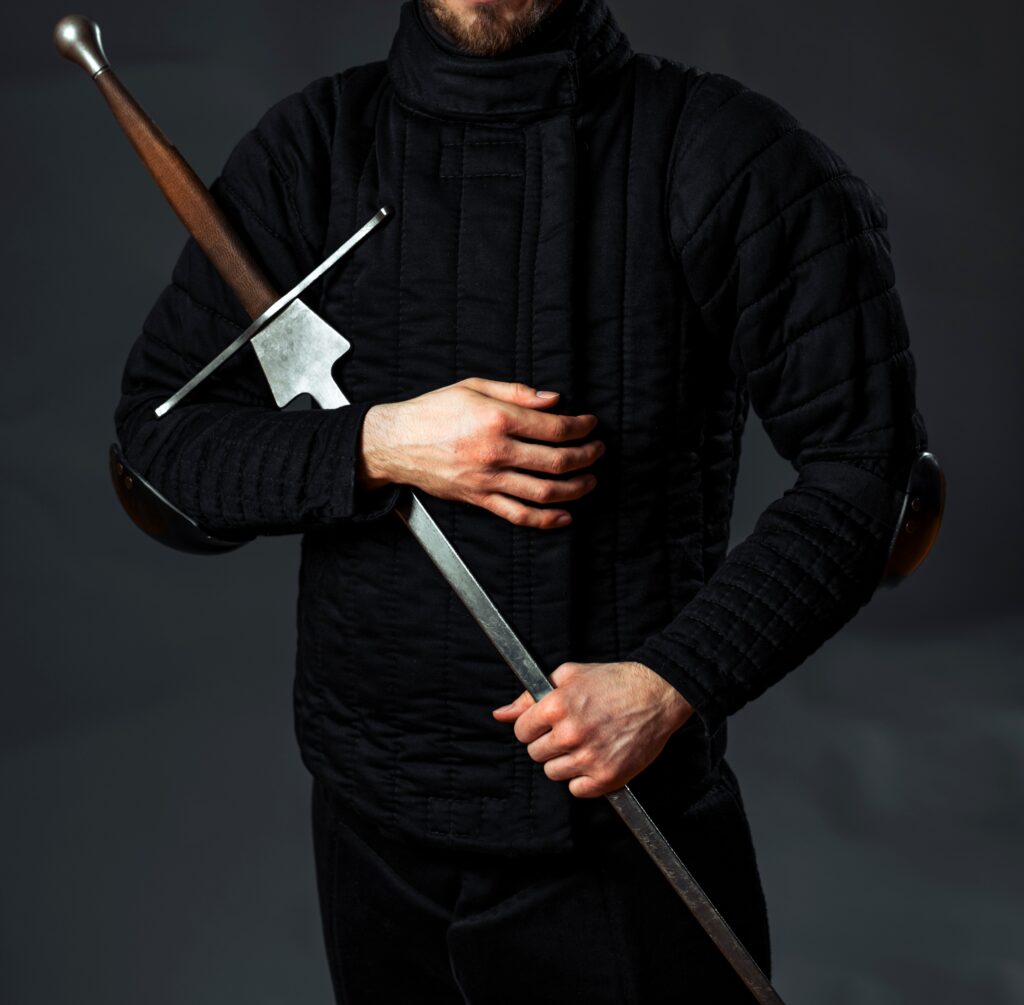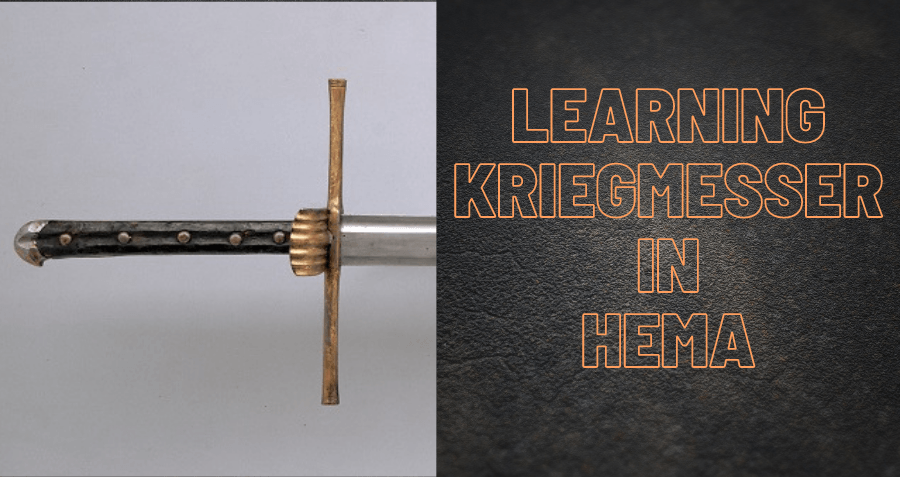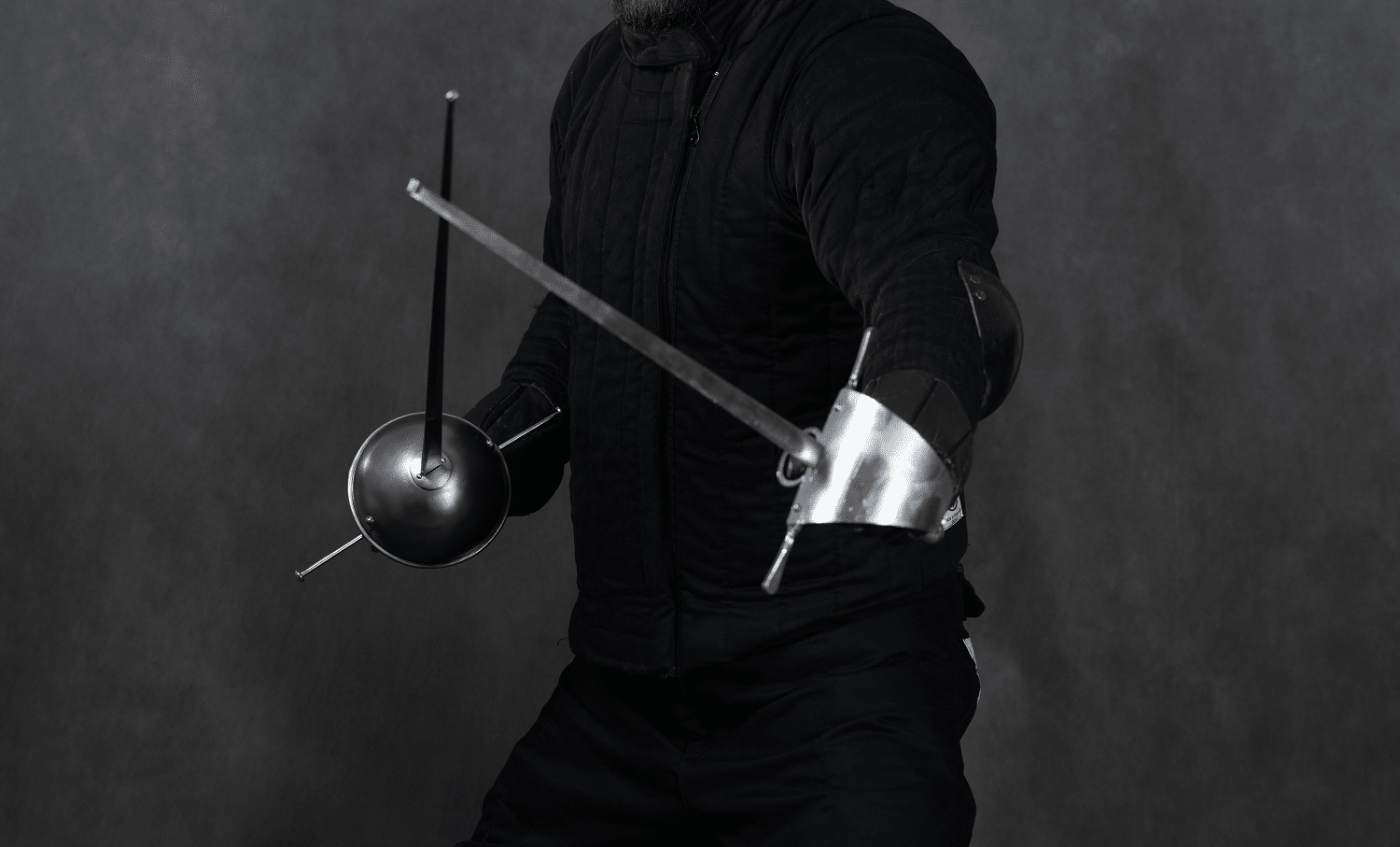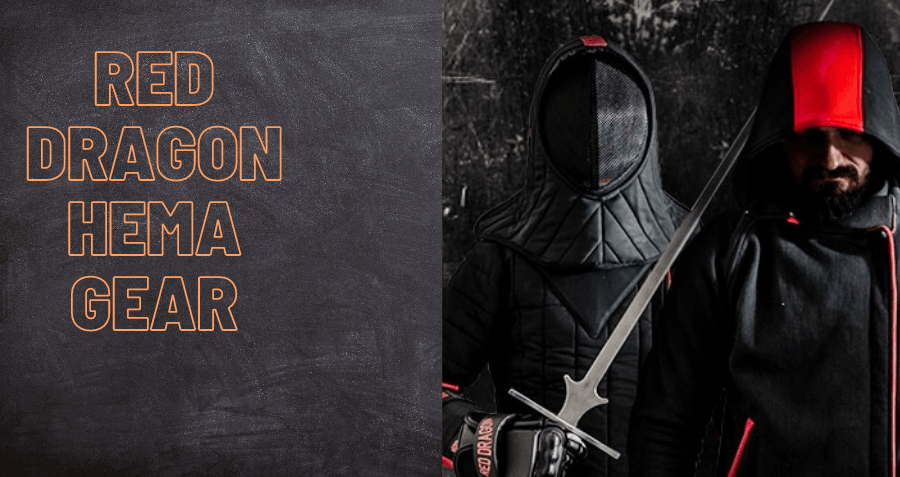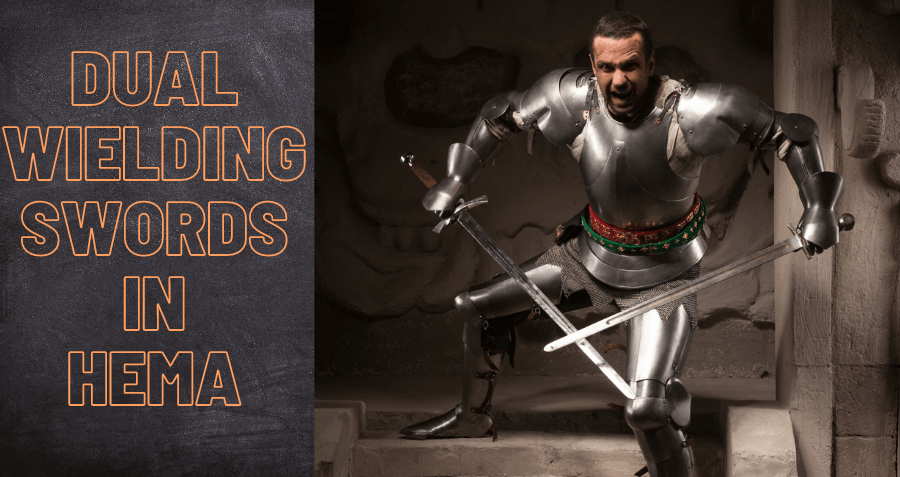If you ask the average Historical European martial artist what weapon they study they will tell you they study the ‘long sword’ and then which source they base their interpretation on. Fechtbücher, or fighting manuals, are the surviving records of historical systems of martial arts left behind by late Middle ages and Renaissance authors and these are the most heavily studied by those within the HEMA community. We discuss briefly the most common source manuals studied by historical European martial artists in our Path of the Long Sword page but as with all studies of historical documents it is important that we examine the historical context behind them in order to correctly assess what the authors intend.
Historical context refers to the social, religious, economic and political conditions that existed during a certain time and place. To speak about historical context means the details of the time and place in which a situation occurs, and those details are what enable us to interpret and analyze works or events of the past, or even the future, rather than merely judging them by contemporary standards (Fleming, 2020).
It is critical that we consider the historical context of the past when attempting something as ambitious as reconstruction of fighting styles depicted in fighting manuals that were written hundreds of years ago. Unfortunately in our lifetimes many individuals engaging in discussions about swords are hobbyists who may be amateur historians with unclear methodology in how they research swords and frequently repeat things they have heard from questionable sources. To provide an example of this, it is still extremely popular among sword enthusiasts to refer to great-swords such as zweihander and montante as “claymores” despite the fact a claymore is an entirely different type of sword and the propagation of the misuse of the term dates to mistakes made in the 1911 edition of the Encyclopædia Britannica (Wagner, Christopher, 2005). In reality the proper historical origin for ‘claymore’ is the Scottish Gaelic claidheamh mòr which roughly means “big/great sword” but when historical context is considered the term references a broadsword, while claidheamh dà làimh is the correct terminology used to refer to “two-handed swords” such as great swords (Armstrong, 1825).
This is relevant because HEMA clubs are predominantly studying ‘the long sword’ but what is defined as ‘long sword’ is not universally understood. With that in mind let us now explore the contemporary label of the ‘long sword’ and what that label means within the context of HEMA.
What is the modern meaning of a ‘long sword’? It’s not always clear.
The first matter we must consider is that our modern usage of the term ‘long sword’ is not aligned with the historical meaning intended in the manuscripts we study. When contemporary authors read treatises they typically translate phrases such as “two handed sword” or “used in two hands” as ‘long sword’ but this can be done erroneously as these phrases were not always used consistently by authors.
For an example of these inconsistencies, whereas Fiore de Liberi’s The Flower of Battle treatises described a “sword in two hands” (spada a dui man; written as “spada a doe mane” in the Morgan and “spada a doy man” in the Getty) the the English typically called a sword of the length depicted in Fiore’s illustrations a ‘bastard sword’ (a loanword borrowed from the French l’épée bâtarde). The Masters of Defence competition organised by Henry VIII on July 1540 listed two hande sworde and bastard sword as two separate items, clearly intending them to be different types of swords (Strutt, 1801).
We also know that a man who was trained in the use of the great sword would be granted the title of Meister des langen Schwertes (Master of the Long Sword) by the Order of Saint Mark (Marxbrüder) which operated as a kind of guild in 16th century Holy Roman Empire Frankfurt. This was a necessary qualification to possess in order to be employed as a Doppelsöldner using a great sword in the Landsknechte during the Italian Wars of 1494–1559 (Clements, 2004).
Now there is over a century of difference between the estimated writing of Fiore’s work and Henry VIII’s competition, and ‘bastard’ is thought to be in reference to a style of sword that is a transitional type between the previous swords used by crusaders in the 11th to 13th century, and the latter great-swords of the Renaissance. Understanding this is part of the context needed to understand what authors were talking about during their own lifetimes. This ‘bastard sword’ is often assumed to be the kind of sword the treatises studied in the Liechtenauer tradition discuss the usage of, as well as what is shown by authors such as Philippo di Vadi.
While this is generally understood among the community a definition of what a ‘long sword’ within the context of HEMA should still be considered rather than just assumed. While it is easy to want to say that all swords with an extended handle ought to be called a ‘long sword’ as the Wikipedia article on the subject wants to do, this description greatly simplifies what is actually a fairly complicated topic. Blade and hilt styles are not merely decorative; different shapes have an impact in the functional usage of the weapon. As an example surviving Bronze age swords often have a curvature to the ricasso of the blade just before the hilt to provide protection to the swordsman’s hand by deflecting the weak of the opponent’s blade away from the swordsman’s body in a manner similar to what federschwert schilts do.
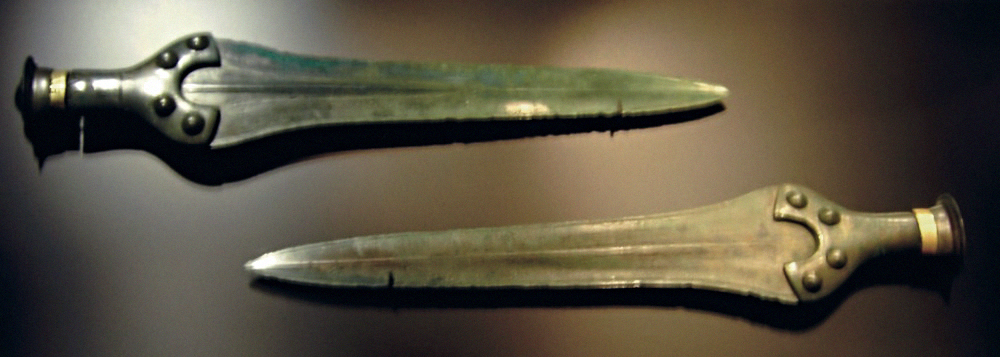
This principle of a lengthened piece of blade in the ricasso before meeting the hilt is continually seen throughout the evolution of European swords until finally abandoned in double edged straight blade design by the time rapiers are developed.
The transition of the rapier is interesting and particularly relevant to the question of “What is a long sword in HEMA?” because rapier blades are a transition from the side-sword (spada da lato). Side-swords typically had blades with similar forging techniques and geometry to that of two handed swords produced in the same period. When side-sword, long sword and rapier blades are not examined separately (as researchers such as Michael Oakeshott have done) but instead holistically we see a clear evolution of sword blades from triangular shaped blades to straight and narrower blades designed to maximize penetration power for thrusting actions while improving the length of the blade for half-swording techniques, before half-swording is abandoned in favor of blade styles such as that used by rapiers. We should also consider the broadsword styles developed around the same periods, and how these might influence blade typology trends in straight double edged blades.
It is widely believed today that the gradual narrowing of the ricasso coincides with the development of steel plate armor in Europe, in particular plated armor that protects the hands and arms (thereby making a wide ricasso unnecessary on the blade to protect these areas) and plating that protects critical areas of the body such as the head and torso (which makes a sturdier more narrow blade with a triangular tip more effective at piercing gaps and weak areas of the armor). As full body armor of these time periods were generally compositional (with pieces forged at different times by different craftsman and used in combination with chain mail, gambesons, doublets, jerkins and other kinds of inner wear and outerwear) we see the sword become more focused on penetrating through weak areas of the outfit and advancements in blade design intended to make this penetrating easier.
Interestingly as heavy armor becomes less prominent in war due to the changes in tactics (such as phalanx polearm centric formations and the introduction of cannon to the battlefield, referred to as ‘pike and shot‘) we still see the sword continue on this evolution toward emphasizing the power of the thrust and this develops the side sword into the rapier. We can pinpoint this change — it coincides with the publication of Camillo Agrippa’s 1553 manual Trattato di Scientia d’Arme, con vn Dialogo di Filosofia (“Treatise on the Science of Arms, with a Philosophical Dialogue”). While previous authors such as Vadi had discussed the importance of geometry in sword fighting none had done it to the extent that Agrippa did (Mondschein, 2014).
In contemporary discussions about 15th century “long swords” it is common for people to be informed that these swords were primarily focused on thrusting when used against heavily armored opponents (typically with the swordsman grabbing part of the blade in one hand to engage in what is called “half-swording”), but what is often overlooked is the impact of the loss of a wider ricasso before the hilt and how this affected piercing attacks.
Blade types which lack wider riccasso generally weigh the same as their wider bladed cousins. This means they possess about the same amount of metal but the metal is used in a different way; often to increase the length and durability of the blade, but also to bolster the blade for the endurance of half-swording actions against plate armored opponents who may also be wielding maces and spears which the knight must defend against using their sword defensively. There even appeared a type of sword specifically designed to make it easier for armored combat called the estoc, which has the length of the blade unsharpened and hardened more like a rod to make it easier to half-sword with.
The average characteristics of a long handled sword is usually given as overall approximately 44″ and 54″ (112 and 137 cm) in length, weighing roughly three to four pounds (1.4-1.8 Kg) with a straight, double-edged blade whose shape could be flat and wide, narrow and hexagonal, or diamond shaped (Loades, 2010). It is this specific shape we must focus on to properly date the weapons by their creation, rather than merely by when the weapon might have been in service. Due to their high cost of sword production relative to other goods it is possible a sword could be used for multiple generations, just as firearms today produced more than fifty years ago are still routinely used. As an example a Colt 1911 .45 pistol is surely still a useful weapon for battle which is why it is still used by some military units within the US Army as a special request, but the pistol is outclassed in performance by several other pistols which is why it has not been a standard service weapon by the US Army since 1986. It would be inaccurate for later historians hundreds of years from now to claim the Colt 1911 .45 pistol was invented in 2020 just because a handful of special operative soldiers still choose the weapon out of preference; likewise it is inaccurate to say just because a specific sword might have been used by someone during a certain year means it is reflective of what was commonly used during that year or even representative of what is the latest trend in sword design for that year.
A close examination of Fiore’s tradition implies great transitions in sword design within a generation
More insight about the weapons can be obtained by examining the source manuscripts of fighting technique themselves. Philippo di Vadi produced his treatise De Arte Gladiatoria Dimicandi (“On the Art of Swordsmanship”, MS Vitt. Em. 1324) some time between 1482 and 1487, which is believed to be at least seven decades after the production of the Getty version of Fiore’s treatise. The current scholarly consensus on Vadi’s treatise is that he copied substantial parts of it from Fiore’s treatises during his employment with the d’Este family (who owned copies of Fiore’s writings, including what is now known as the Getty) though examination makes it obvious that Vadi interjected some of his own opinions and thoughts into his version of Fiore’s Armizare system.
Vadi tells us that the blade of his sword is sharpened only four fingers close to the point, which means the majority of his blade is unsharpened (Morini, 2012). This could imply something akin to an estoc. Furthermore the illustrations of the sword used in Vadi’s treatise are of a very different typology than the sword depicted in the Getty.
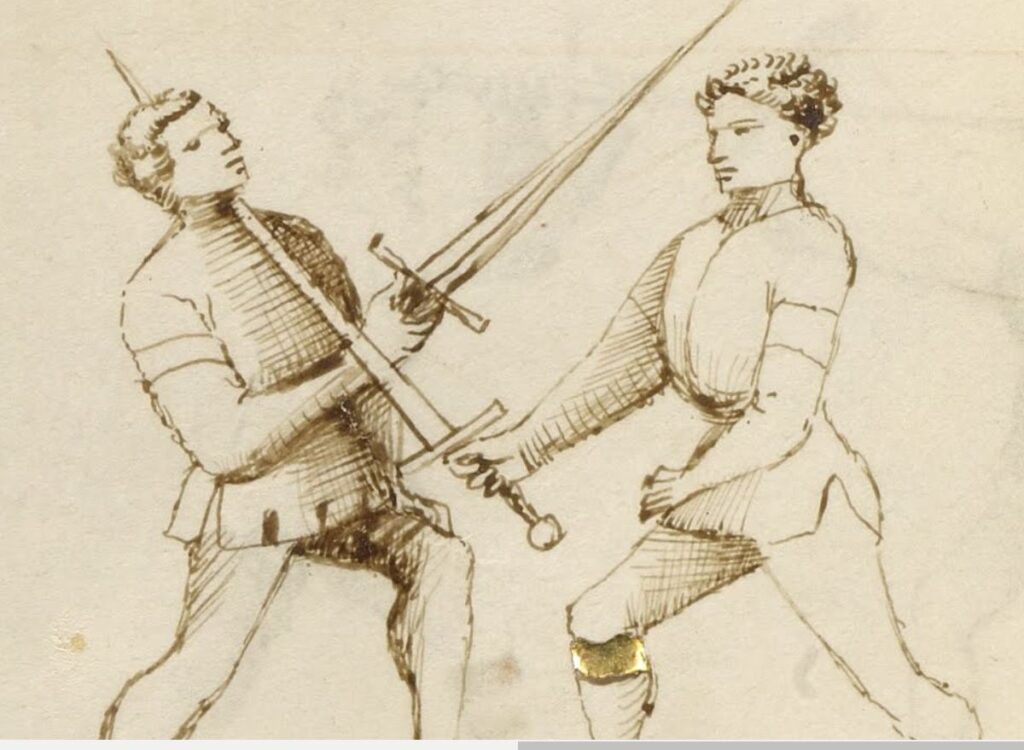
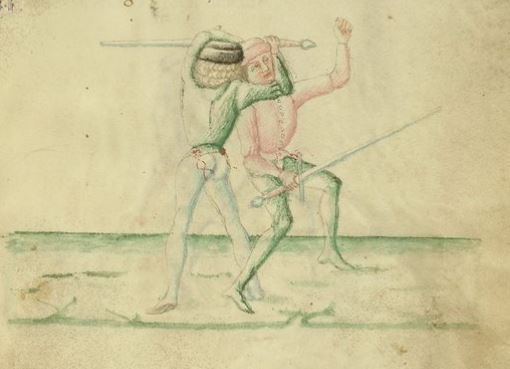
While iconography analysis of rough sketches is by no means absolute as it is prone to be highly subjective, it seems clear that Vadi’s sword is a different style than that of the one depicted in the Getty produced almost a generation prior. The length of the handle is longer with Vadi, the blade generally depicted as being more narrow. By contrast the majority of the images of the sword depicted in the Getty depict a shorter, more triangular shaped blade, with a thicker riccasso than that of the sword in Vadi’s work.
We see something else unique in comparing the treatises, particularly in the horseback combat section of the Getty;
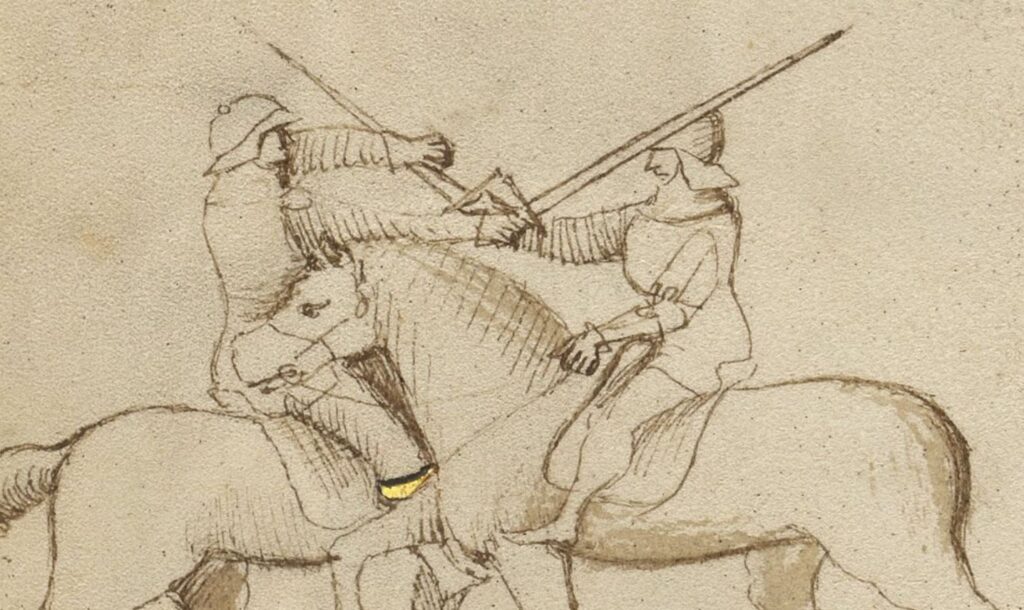
Unusually several illustrations from this section of the Getty depict a different kind of sword than shown in the rest of the manuscript. This inconsistent detail is largely in the hilting of the sword; this is very clearly a sword with a shorter handle than the others. Yet nowhere in the text does Fiore specify that this sword is different than that used elsewhere in the treatise. As its plays are intended to be performed one handed it is more useful to perform them with a shorter handled sword that slips less in the grip while horseback and is easier to wield so it is not unusual that we would see a shorter handled sword used for mounted combat but the inconsistent depiction of handle lengths throughout the Getty stands out.
Now while this detail is entirely possible to be a mistake on behalf of the artist, it is a mistake that occurs in two separate manuscripts that are stated to have been created at the same time (this irregularity of the sword hilt types also appears in the Pisani Dossi) so another radical possibility exists; that perhaps the Getty is not an original manuscript drafted under the supervision of Fiore as many assume it to be.
This possibility exists for several reasons;
Firstly the preface of the Getty mentions the manuscript has been organized according to the wishes of Niccolò. Other versions of Fiore’s manual do not have this detail. So we at least know in this treatise that the work has strayed from Fiore’s original intentions.
Secondly the Getty manuscript uses rough sketches for illustrations, which could possibly indicate they are the result of a copy, possibly made using the pricking technique common to manuscript production during this era. For support of this theory we can note that the MS Pisani Dossi possesses illustrations of a similar sketched style as the Getty, though its preface implies it was organized according to Fiore’s wishes.
Thirdly in comparing the Pisani and Dossi some techniques are either not appearing in the other, or depicted differently. A strange detail.
Fourthly records exist in the d’Este family library that imply two older treatises of The Flower of Battle once existed in their care. In the footnotes of the paper ‘The Flower of Battle of Master Fiore Friulano de’i Liberi: Being a Concordance of the Prefaces and Several Plays from His Four Extant Manuscripts‘ (2016) Michael Chidester writes,
The Codex LXXXIV (or Ms. 84) consisted of 58 folia bound in leather with a clasp, and whose first page showed a white eagle and two helmets; the Codex CX (or Ms. 110) was a small, unbound volume consisting of only 15 folia. Both manuscripts are mentioned in the catalog of the d’Este library as late as 1508, along with a third untitled fencing manuscript, but they disappeared some time after that and never resurfaced. See Novati, Francesco. Flos Duellatorum, Il Fior di Battaglia di Maestro Fiore dei Liberi da Premariacco. Bergamo: Instituto Italiano d’Arte Grafiche, 1902. pp 29-30. It is conceivable that one of the four extant versions is a fragment of the Ms. 84, but no evidence in support of this proposition has yet surfaced.
It is possible the Pisani Dossi and the Getty are two copies of the original treatise that have been produced at the same time by different artists, each copying from pricks made of the original work and this resulted in inconsistencies. For support of this the Pisani Dossi depicts different kind of armor with details not appearing in the Getty, but the type of sword in each scene is very consistent to the Getty.
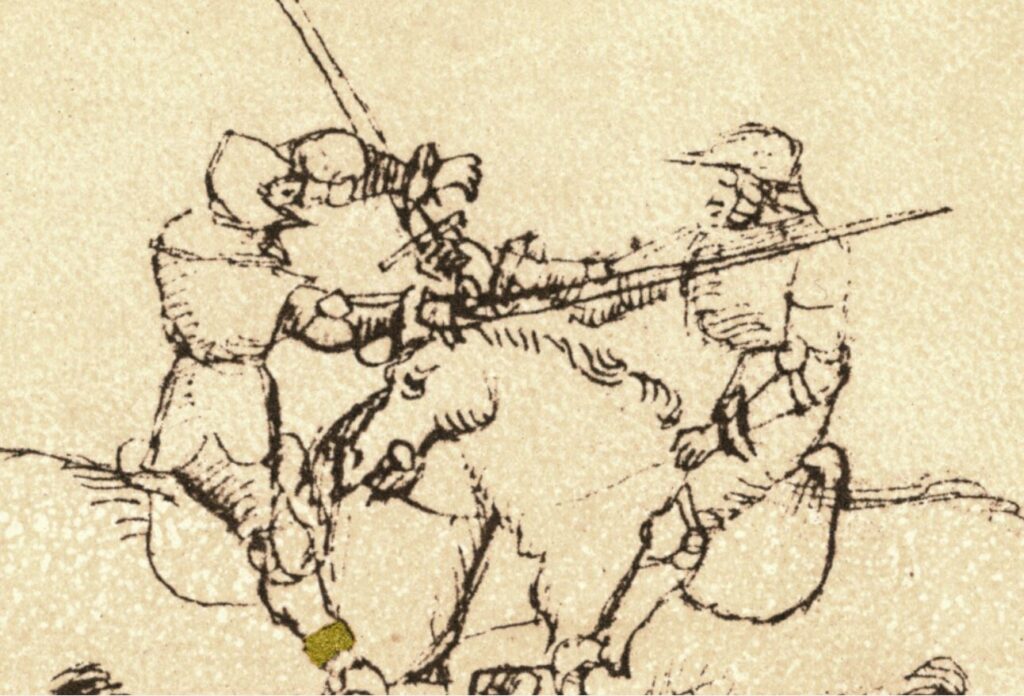
These details considered together might imply both manuscripts were produced by different artists working from the same original illustrations — a potentially “lost” original treatise whose production was directly supervised by Fiore and was produced earlier than either the Getty and the Pisani-Dossi. And that during the copying of this original attempts were made by two different artists to update the arms shown in the manuscript by the request of the de’Este family, but this updating was not consistently uniform between both reproductions.
This is all speculation of course, but we can theorize several reasons for why the original (if it existed) may have been copied, ranging from the work becoming damaged to a desire to update its imagery for current arms.
Regardless of this speculation the important takeaway from this analysis is that illustrations exist in Fiore’s earliest known recorded works that depict a typology of sword very different from that shown by Vadi; specifically a type of sword that is associated with dates before the widespread availability of plate armor; something like a type XVIII, VX or even XIV from Oakeshott’s typology (Arnow). These types of blades possess that same widened ricasso which as we have pointed out previously existed on swords to provide additional defense to the hand the way that a schilt on a federschwert does. This could mean the original treatise of Fiore may have depicted a fighting style that predates the widespread usage of plated hand and arm protection. For evidence of this Fiore tells us in his preface that he participated in duels wearing only a gambeson and chamois gloves. A sword with a wide ricasso is consequently advantageous for defense.
What did the authors really intend to teach?
For now, let us consider this: were the treatise authors speaking about old swords that may be inferior at the time they wrote their treatises, or were they talking about swords that were state of the art for their era, widely in use and gave their wielder’s an advantage in battle over older arms? Probably the latter would be our guess since part of the point of drafting these treatises was to show off one’s skill and knowledge. Showing off the usage of inferior arms would likely not have impressed their contemporaries and could even be a motivation for the d’Este family to want Fiore’s treatises illustrations updated as arms changed.
Considering all of the information we’ve discussed so far, if we were to narrow on a standard definition for what a ‘long sword’ in HEMA should be, we first must acknowledge that the kind of sword depicted in the Getty is not the kind of sword depicted in Vadi, and is not the type of sword depicted in Meyer, either. While many of these swords are able to use the same techniques they are not identical weapons intended to fight against the same precise kinds of armored opponents and while wearing the precise same kinds of armor, but rather they describe systems of combat specifically for fighting the kinds of opponents the author would face during their own lifetimes and while wearing the armor most common for these periods of history too. Significant advancements were being made in the design of the sword in parallel to the advancements being made in creating armor; even a decade of difference can be significant.
Our point here is that to accurately reconstruct these systems as each author intended one needs to also consider the armor the opponent would be wearing — something that is often not done in HEMA long sword reconstructions because there is a common assumption among contemporary practitioners to believe that armor was not used in sword fighting all of the time. However what the manuscripts actually depict is usage of light versus heavy armor, and we are too focused on the specific words used in the manuscripts to understand the historical context of what the authors meant when they separated sections into “armored” and “non-armored” sections. In the same way that authors would say “sword in two hands” to mean a particular type of sword that is different than “bastard sword”, the authors concept of what “armor” is in their time period most often meant should be considered and attempt to be understood. Many of the illustrations in fechtbücher show fencers wearing doublets in these “unarmored” sections, which while we may consider to not be armor based on their depictions in illustrations to be fashionable, does not truly give us an idea of how protective they actually were.
It can be reasoned that given the dangerous times of the individuals we are researching it can be surmised that if they felt the need to carry swords around their person for self-defense then they probably wore at least light armor commonly, too — as did the opponents they would need to face in self defense, who might be robbers specifically prepared for a fight and wearing armor in anticipation of a battle.
How swords were used in surviving fechtbücher matters
Regardless of whether you study Fiore or Liechtenauer based traditions, all of the plays basically boil down to one of three main scenarios.
- What to do after winning a bind.
- What to do if both fencers are equally strong in the bind.
- What to do if you lose the bind.
Depending on the circumstances of the specific situation you are in, both traditions have generally similar types of answers for these questions. The plays are techniques but the purpose in showcasing them is to teach concepts that can be applied in other scenarios. There are similarities between plays across traditions, and from different masters within them, but there are differences as well. These differences may result from slightly different blade characteristics.
For example swords with wider length in the ricasso above the crossguard provided more hand protection by deflecting blows away from the hands and arms, which became less necessary as steel gauntlets became common to protect the hands and importance was placed on grabbing the blade to spear an opponent using half-swording. Using our example from The Flower of Battle again, suppose that Fiore really did intend his art to be used with a sword sporting a wide ricasso and triangular shaped blade. If this is the kind of sword Fiore intended his style to be used with then should those studying Fiore not try to use a simulator that best models this type of blade typology in order to fully appreciate the details of his plays?
By contrast later fechtbücher in the Liechtenauer tradition depict a longer sword with a more narrow ricasso. So a sword of this type might be more appropriate for a Liechtenauer fencer.
Ultimately the long sword tradition source material we have today ends with Meyer and Jakob Sutor von Baden, and with Meyer we see the introduction of techniques specifically designed to take advantage of the characteristics of what we call today a federschwert. This should also be considered, that Meyer developed techniques to take advantage of the federschwert design. Would prior masters also not have done the same for the types of sword typologies they used?
So what then is a ‘long sword’ in HEMA?
The answer we conclude with is that there isn’t precisely one type of sword that can be rightfully stereotyped as the ‘proper long sword for HEMA’, as each generation of master had himself a slightly different kind of weapon that while might be used fundamentally the same as one another, did possess characteristics that influenced the specifics of how that weapon was used in actual practice. So when virtually all contemporary fencers utilize federschwert designed to replicate the kind depicted in Meyer, some key details of older traditions may be lost by not using a sword simulator that better mimics the characteristics of the sword originally intended to be used by the treatise author the HEMA fencer is actually studying.
Furthermore it may not be accurate to suggest that all swords with long handles should be labeled as a ‘long sword’ for the purposes of understanding these treatises. Certainly the kind of sword depicted in Fiore’s mounted combat section would not best be able to deliver the kind of specialty blows that Meyer later shows that depend upon certain qualities that Fiore’s sword would not possess. It is therefore confusing and largely inaccurate to suggest any and all swords that have extended handles should be “long swords” and are interchangeable with any tradition manuscript; rather the specific types of swords that can be assigned to the period of time the master lived and best able to utilize the techniques they describe (evident through the practice of their art) is what should be focused on when studying that master’s tradition in order to reconstruct their arts as close to their original intentions as possible.
The challenges in narrowing specific dates for the transition of sword designs
There are people who will disagree with the conclusions we have made, as it is against the common consensus others have arrived at. The primary disagreements with our viewpoint will be that many museums today hold collections with arms from various periods listed with corresponding dates for when that weapon or armor was first created and these dates are taken at face value as being accurate.
It is therefore worthwhile to first discuss what methods are used to date such objects, and then to discuss the merits of each method and their potential drawbacks that can lead to inaccurate dating.
Historians today use three main methods to accurately date European swords: carbon dating, metallography, and metallurgical examination, and circumstantial evidence. Carbon dating is by conducting radiocarbon (14C) measurements from swords retrieved from archeological sites (Walker, 2013). This is done by grinding the sword to remove the corrosion layer and small pieces of the iron removed. These pieces are then assessed for their carbon content. The radiocarbon measures are used to estimate the period during which the sword was made (Hüls et al., 2019). However, the use of carbon dating for swords is often problematic due to contamination and dilution. The use of multiple pieces of metals such as iron and steel in making swords and contamination from coals or charcoal often leads to difficulties in dating iron swords (Cresswell, 1992). These same issues apply to dating of surviving metal armor as well. As it is a destructive process this kind of dating is often not done on surviving pieces of arms owned by museums and collectors intended for display, and tends to only used on already severely deteriorated pieces.
Further complications also exist. Up to at least the 10th century pattern-welded swords were the most predominant in Europe. These swords were made using multiple pieces of different metals welded together (Williams, 2003). Such swords are hard to date, considering that the metals used may lack contemporaneity. Consequently the use of iron dating requires a thorough metallographic examination to determine these factors. The accuracy of dating swords is dependent on the establishment of contemporaneity carbon and minimal contamination (Cresswell, 1992). Radiocarbon dating is a common method of dating swords but may yield inaccurate results without a combination of metallography.
The dating of swords is also done through metallography and metallurgical examination. This is done through the analysis of the microstructure of a sword. This process entails the examination of the physical, chemical, and metallic characteristics of a sword, as well as the assessment of intermetallic elements and mixtures such as alloys. It includes the use of microscopy to test the elements used in making a sword (Hüls et al., 2019; Williams, 2012). This method starts with the analysis of the physical features of a sword, such as its length, weight, shape, and design. Other physical features that may be used in dating include visible inscriptions; Samples are then taken from different parts of the sword (pommel, crossguard, and blade) are then subjected to further tests to measure for aspects, such as microhardness and slag content, under laboratory conditions (Hošek et al., 2012). When dating swords made in the 10th to 15th centuries this method has been used, especially in consideration of the different patterns and metal composition of blades within this period. Up to the 10th century blades were made of small pieces of different metals welded together. Starting in the 11th century this pattern of blades was used less often because larger steel pieces were available to make swords. Based on this analysis, blades with a combination of pieces of steel and iron will most likely be dated not later than the 10th century, while those with a homogeneous piece of steel would be dated much later, but this can often be based on assumptions rather than on more concrete testing of the sword.
The third method of dating swords is based on circumstantial evidence. This method relies on the use of other factors to predict the date that a sword was made. In particular swords excavated in former battlefields are easier to date because they are believed to have been used in these battles. Similarly the dating of a sword can be done by assessing its typology and dating it back to the period that that typology was predominant. For instance, swords with flat, broad cutting blades are usually dated before the mid-14th century when plate armor was introduced. However, this dating approach is often inaccurate because swords were often passed down several generations. Consequently, a sword found in a battlefield dating back to the 15th century, for instance, could have been originally made in the 14th century. We also have to consider that it is relatively easy to dismount a sword blade and alter the hilt to replace worn parts. As a result, the dates when the parts of a single sword were made could be centuries apart (Oakeshott, 1991). Given the challenges posed by this approach the dates obtained are often an estimation that is often inaccurate.
Sword Forgery and Challenges Encountered in Sword Dating
In the past there have been mistakes in dating swords, sometimes as a consequence of intentional deception. The dating of swords with scientific analysis has often helped in the identification of swords with fraudulent attributions to their origins. Some of the well-known fraudulent swords are Tizona and Colada, swords attributed to having belonged to Rodrigo Díaz de Vivar, also known as El Cid or Campeador. The two swords are famed in stories for winning El Cid the combat from Valencia’s King Yucef and the duel with the Count of Barcelona. The swords were said to have been made in the 11th century, but the ones existing in museums today are believed to be forgeries. The authenticity of these swords is doubted as a result of inconsistencies in the dating of their hilts. For instance, Colada has a decorative 16th-century hilt. The forgery of swords is often motivated as a result of their symbolic value. For example Tizona was believed to drive fear into the hearts of unworthy adversaries and is deeply associated with the story of El Cid who is a national hero (Pendergrass, 2015). Scientific dating of swords is therefore essential in differentiating between popular swords of earlier centuries with forgeries made centuries later.
Despite the critical role played by the dating of swords in identifying their authenticity once excavated this process is often inaccurate owing to several factors.
Firstly, swords that date as far back as the medieval period are few and often in bad shape. Most of the swords are difficult to date because they offer very little evidence pointing to the time they were made apart from their internal evidence.
Secondly, the usage of swords spans several centuries, which may lead to errors in dating owing to modifications of the sword and dating a sword based on where it was found. Swords were often modified over time using materials from different periods. When dating such swords, its different components of the swords may have differences of centuries in dating.
Similarly, swords dated based on events such as wars could often be made years or centuries before the wars.
Lastly, since the dating of a sword is often based on the time a sword was mounted on the hilt, an event which may have taken place years after it was originally made or redone several centuries later, basing the process on aspects such as the blade characteristics may lead to inaccuracies (Oakeshott, 1991). The dating of swords made between the 10th and 15th centuries faces several difficulties, which make it difficult to arrive at the accurate age of these swords.
The challenges in dating swords have often led to many errors in dating. Additional archaeological finds often help historians to identify and correct these errors (Oakeshott, 1997). The errors in the dating of swords may necessitate the use of modern techniques to establish the period during which a sword was made correctly. Given the shortcomings of the existing approaches it is critical to consider using multiple dating methods depending on the available information. In particular the combination of carbon dating with the metallurgical examination is an effective way of dating swords (Cresswell, 1992). These approaches can be combined with any existing circumstantial evidence to give a more accurate estimation of the time a sword was made. For instance, a sword discovered in a site where a battle was fought in 1400 can be carbon dated and subjected to metallurgical examination for higher accuracy instead of assuming that it was made the year the battle took place. It is common to find that such a sword was made several years before but was only deposited in its discovery site during the battle.
Swords in 10th-15th Century Europe and Transition from so-called Knightly Sword to so-called Longsword
Several types of swords can be dated back to between the 10th and 15th centuries. One category includes swords made in the Viking Age, which are often categorized as type X. These swords are mainly dated between the 9th and 12th centuries. They are characterized by a wide variety of hilt forms, including the early Viking form, a wide blade, and pommels shaped like mushrooms or brazil nuts (Peirce & Oakeshott, 2002). The second category of these swords is Type Xa swords, which are similar to the X swords but with a narrower blade. The dating of X and Xa swords is not very different because they were both predominant until the 12th century (Oakeshott, 1991). The other types of swords dated to this period is types XI and XIa (Oakeshott, 1996). These are swords that had a long, slender blade. The blade was considerably longer than the hilt. The other type of sword is type XII, which constitutes of swords with a noticeable taper and an acute point. Their grip is short. These swords have been dated from the 10th century to the 15th century when their use continued. Other common sword types include type XIII-XIIIa that was common in the 13th and 14th centuries. These are swords with blade edges run almost parallel to each other and have a rounded point. The tang of these blades is also considerably long. Type XIV was also a common type of sword in between the 13th and 14th centuries. Blades under this category have a short grip and blade. The crosses of these blades are long, and they are broad at the hilt. In the 14th and 15th centuries Type XV-XVa was also common and featured swords that look similar to the XIVs but had a very pointy end aimed at delivering a lethal thrust even when the opponent was wearing armor (Oakeshott, 1991). There is a wide variety of sword types dated between the 10th and 15th centuries, which share certain characteristics but have an indication of evolution over time.
It is popularly believed today that between the 10th and the 15th centuries there was a transition between the so-called knightly sword to the so-called longsword, which corresponded to the changes in the sword typology of the period. In contemporary usage the knightly sword label generally refers to swords in the types XI, XII, XIII, and XIIIa. They were short and light swords used that were predominant between 1000 and 1350 (AEMMA, 2020). A dagger often accompanied this sword. On the other hand the longsword label generally refers to a commonly used type during the late medieval period (1350-1550). These swords were commonly held with both hands. They could serve all purposes, including cutting, thrusting, and striking (AEMMA, 2020; Ayton, 1999). The transition from the knightly sword styles to the longsword styles may have been informed by the increased need for specialty swords in battles to deal with new types of armor encountered. Besides this, the introduction of plate armors may have motivated the introduction of swords capable of thrusting through it. However much of this is speculative based on examination of the characteristics of the blades themselves and comparison of armor used at the time, with surviving fechtbücher from this time period not necessarily examined by scholars when making these judgement calls.
Conclusion
To come full circle and summarize what we have discussed, we started this article by asking the question ‘What is a long sword in HEMA?’ and discussed the inconsistent usage of labels to refer to swords throughout history and how this inconsistent labeling of swords still exists today.
We also examined some surviving fechtbücher to demonstrate there is evidence to suggest even if they do describe the usage of a sword wielded in two hands that not all fechtbücher necessarily refer to the same style of swords and differences in blade geometry can influence their usage. We further discussed how we cannot simply assume the illustrations themselves from surviving fechtbücher are accurate to the blade style the treatise author intended as some of these illustrations may have been created without the direct involvement of the treatise author and while some authors do say their tradition can be used with many kinds of blades, their perspective is limited within the historical context of what sword blade shapes they knew to exist during their own lifetimes.
Lastly we discussed the challenges in precisely dating a sword to its original date of manufacture or how long it was even used as a weapon for battle, so simply going by dates of arms listed in museum displays is not the best approach to assessing what kinds of swords the surviving fechtbücher are depicting.
We conclude this article with the belief that ‘long sword’ is, while a widely used label within HEMA, a misnomer and that if the desire for HEMA practitioners is to accurately reproduce the fighting traditions described in the treatises we study we should attempt to accurately reproduce the design of the arms they used as well, instead of just using federschwert in a style that has become ubiquitous but mimics only one kind of sword type. Important details not specifically mentioned in the treatises can be missed by not having familiarity with how different blade shapes impact the practical application of the fencing plays these manuals describe, potentially causing us to miss details that would be obvious to the treatise authors but are less clear to us today unless we experiment and compare.
Bibliography
Fleming, Grace, 2020. “The Importance of Historic Context in Analysis and Interpretation.” ThoughtCo [Online] Available at: thoughtco.com/what-is-historical-context-1857069. [Accessed 4 June 2020]
Wagner, Paul and Christopher Thompson, 2005. “The words claymore and broadsword” in Stephen Hand, Spada II: Anthology of Swordsmanship. Chivalry Bookshelf.
A Gaelic Dictionary, by R. A. Armstrong (1825) p. 120. see also Wagner, Paul; Christopher Thompson (2005). “The words “claymore” and “broadsword””. SPADA. Highland Village, Texas: The Chivalry Bookshelf. 2: 111–117.. Dwelly’s Illustrated Gaelic to English Dictionary (Gairm Publications, Glasgow, 1988, p. 202); Culloden – The Swords and the Sorrows (The National Trust for Scotland, Glasgow, 1996).
Strutt, Joseph (1801). The Sports and Pastimes of the People of England from the Earliest Period: Including the Rural and Domestic Recreations, May Games, Mummeries, Pageants, Processions and Pompous Spectacles. Methuen & Company. p. 211.
Clements, J., 2004. The Weighty Issue of Two-Handed Greatswords. [Online] Available at: http://www.thearma.org/essays/2HGS.html#.XtoYiqhKhPY [Accessed 4 June 2020]
Mondschein, Ken, 2014. The Number of Motion: Camillo Agrippa’s Geometrical Fencing and the Enumeration of the Body. [Online] Available at: http://www.northernrenaissance.org/the-number-of-motion-camillo-agrippas-geometrical-fencing-and-the-enumeration-of-the-body/ [Accessed 4 June 2020]
Loades, Mike, 2010. Swords and Swordsmen. Pen & Sword Books.
Chidester, Michael, 2016. The Flower of Battle of Master Fiore Friulano de’i Liberi: Being a Concordance of the Prefaces and Several Plays from His Four Extant Manuscripts [Online] Available at: hroarr.com/wp-content/uploads/downloads/2016/08/wiktenauer-Fiore-de-i-Liberi-compilation-2016.pdf [Accessed 4 June 2020]
Morini, Andrea, 2012. About the flat parry. [Online] Available at: http://athroarr.com/article/about-the-flat-parry/ [Accessed 4 June 2020]
Arnow, Chad. Spotlight: Oakeshott Type XIV Swords. [Online] Available at: myarmoury.com/feature_spotxiv.html [Accessed 4 June 2020]
AEMMA, 2020. Sword (spada) / Longsword (spada longa). [Online]
Available at: http://www.aemma.org/content/trng_sword.php
[Accessed 4 June 2020].
Ayton, A., 1999. Arms, armour, and horses. In: M. Keen, ed. Medieval warfare: A history. Oxford: Oxford University Press, pp. 186-208.
Cresswell, R., 1992. Radiocarbon dating of iron artifacts. Radiocarbon, 34(3), pp. 898-905.
Hošek, J., Košta, J. & Bárta, P., 2012. The metallographic examination of sword no. 438 as part of a systematic survey of swords from the early medieval stronghold of Mikulčice, Czech Republic. Gladius, Volume 32, pp. 87-102.
Hüls, C. M., Petri, I. & Föll, H., 2019. Absolute dating of early iron objects from the ancient orient: Radiocarbon dating of Luristan iron mask swords. Radiocarbon, pp. 1-10.
Oakeshott, E., 1991. Records of the medieval sword. Woodbridge: The Boydell Press.
Oakeshott, E., 1996. The archaeology of weapons: Arms and armor from prehistory to the age of chivalry. Mineola: Dover Publications.
Oakeshott, E., 1997. The sword in the age of chivalry. Woodbridge: The Boydell Press.
Peirce, I. G. & Oakeshott, E., 2002. Swords of the Viking age. Woodbridge: The Boydell Press.
Pendergrass, R., 2015. Mythological swords. Lulu.
Walker, M., 2013. Quaternary dating methods. Hoboken: Wiley.
Williams, A., 2003. The knight and the blast furnace: A history of the metallurgy of armour in the middle ages & early modern period. Leiden: Brill Academic Publishers.
Williams, A., 2012. The sword and the crucible: A history of the metallurgy of European swords up to the 16th century. Leiden: BRILL.
*****
We hope this guide helps you start your journey into learning historical sword fighting.
If you’d like to learn more information about historical fencing practices please check out our Learn HEMA page for a guide to learning about the historical weapon that interests you. You can also find more guides we’ve written about other topics at our Helpful Guides page.
